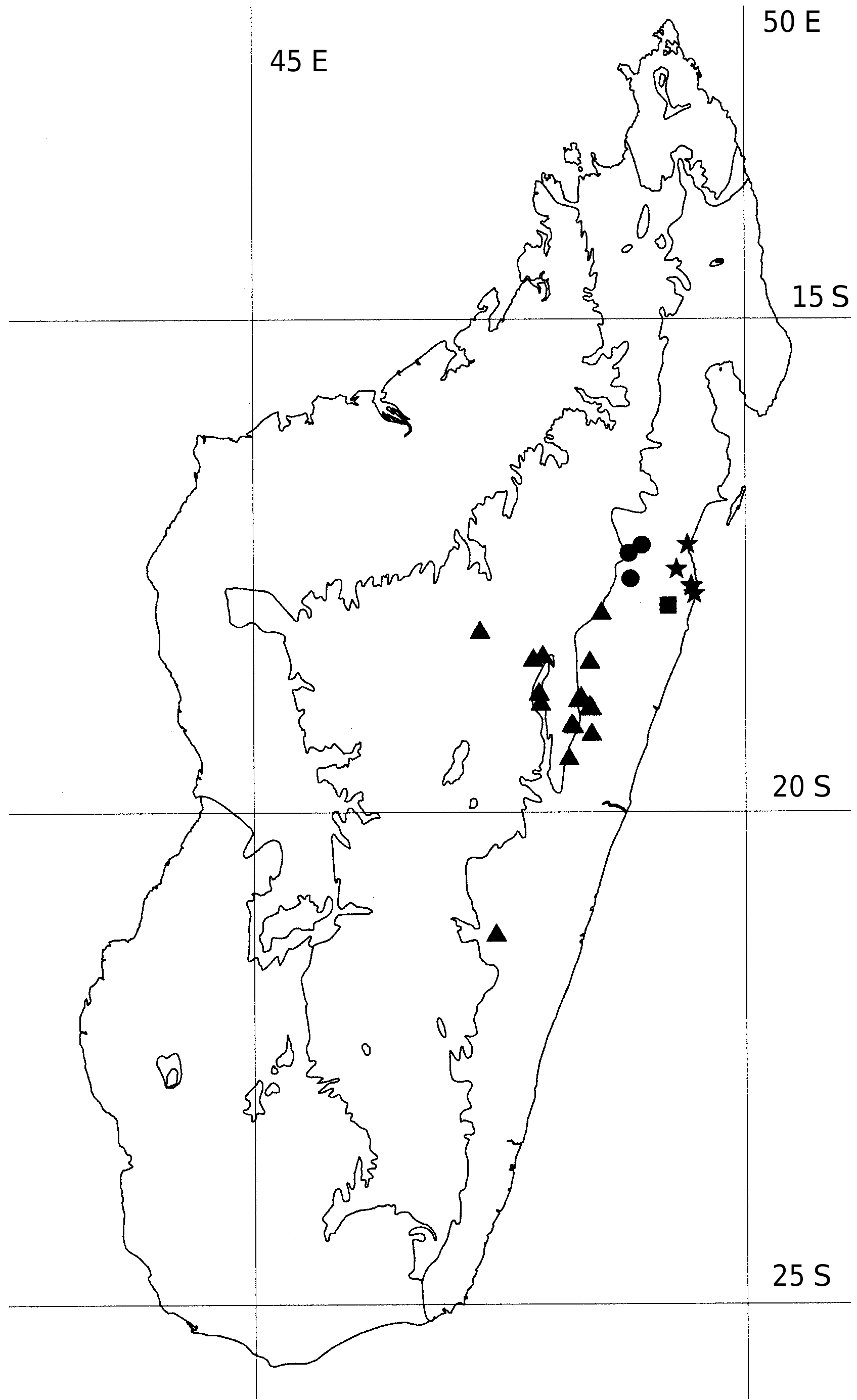Rhodolaena leroyana G.E. Schatz, Lowry & A.-E. Wolf, 2000
|
publication ID |
https://doi.org/10.5281/zenodo.4605922 |
|
DOI |
https://doi.org/10.5281/zenodo.15651416 |
|
persistent identifier |
https://treatment.plazi.org/id/492D879D-FFE0-FFFA-FD20-95F5FE88FB9D |
|
treatment provided by |
Carolina |
|
scientific name |
Rhodolaena leroyana G.E. Schatz, Lowry & A.-E. Wolf |
| status |
sp. nov. |
6. Rhodolaena leroyana G.E. Schatz, Lowry & A.-E. Wolf View in CoL , sp. nov.
Haec species a congeneris foliorum apicibus acutis acuminatisve munitis venatione secundaria rectangulari, ab omnibus involucro maturitate profunde laciniato atque seminibus indumento albo longo densoque obtectis distinguitur.
TYPUS. — Réserves Naturelles 124, Madagascar, Prov. Toamasina, Canton Ambodiriana, Anjiro à la RN1 [ Betampona ], sommet, [ 17°55’S, 49°13’E], 19 Mar. 1954, fl. ( holo-, P!; GoogleMaps iso-, K!, MO!, P!, TEF!) GoogleMaps .
Shrub to tree to 8 m tall, branches glabrous. Leaves with petiole 0.4-0.7 cm long, lamina membranous to subcoriaceous, glabrous, elliptic to slightly obovate, 3.6-12 × 1.3-4.7 cm, base acute to cuneate, apex acuminate to cuspidate, acumen 0.3-1.3 cm long, venation weakly brochidodromous with 5-6 (-11) secondary veins per side nearly perpendicular to the midvein, midvein slightly sunken above, prominently raised below. Inflorescence solitary, axillary, 2-flowered, peduncle slender, 3.5-8 cm long, involucre 5-lobed, with dense golden simple and stellate indument, pedicel 0.7 cm long; outer 2 sepals narrowly elliptic, 0.2-0.7 × 0.2 cm, base attenuate and abruptly truncate, apex acute, the lower half strongly reflexed and then the upper half abruptly bent upwards, the margins revolute for the lower half and then involute for the upper half, densely stellate pubescent outside, glabrous inside; inner 3 sepals ovate, 1.7-2.5 × 1.2-1.4 cm, strongly concave, base truncate, apex obtuse to acute, densely stellate pubescent outside, glabrous inside; petals elliptic, 3.8-4 × 1.7 cm, base cuneate and abruptly truncate, apex obtuse to rounded; disc annular, 0.4 mm in diam., 0.2 mm high; stamens ca. 40, inserted above disc at base of ovary, 3.5 cm long, anthers basifixed and resupinate, 1 × 1 mm; ovary subglobose, 4 mm high, 4 mm in diam., tomentose, style to 5 cm long, exerted, stigma crateriform. Fruit 3-valved, ultimately completely surrounded by the somewhat fleshy, accrescent involucre with deeply laciniate margins, valves broadly ovate, 1.3 cm long, 1.5-1.7 cm broad, densely golden pubescent outside; seeds depressed globose, 1.2 mm in diam., 0.5 mm thick, with dense white wooly indument.— Fig. 5 View Fig .
Rhodolaena leroyana is a shrub to small tree in low elevation humid forest, and is known only from the Betampona RNI, where it was collected earlier this year ( Fig. 1 View Fig ). It is easily distinguished by its leaves with an acuminate apex and 2º veins nearly perpendicular to the midvein (> 80º), as well as its densely golden tomentose ovary and fruit, and seeds covered with a dense, long, white indument.
ETYMOLOGY.— The species epithet honors the late Jean-François LEROY.
VERNACULAR NAMES.— Manasavelona, Tsipatika, Tsipatikala.
PARATYPES. — M ADAGASCAR, Prov. Toamasina: Andrianarisata 127, Betampona RNI, 17°55’S, 49°13’E, 24 Apr. 1994, y.fr. ( MO, P, TEF), GoogleMaps 171, Betampona RNI, 17°55’S, 49°13’E, 29 Apr. 1994, y.fr. ( MO, P, TEF), GoogleMaps 224, Betampona RNI, 17°55’S, 49°13’E, 5 Oct. 1994, fr. ( MO!, P, TEF); GoogleMaps Andrianjafy 86, Betampona RNI, 17°55’50”S, 49°12’12”E, 550 m, 17 July 2000, fr. (K, MO, P, TAN, TEF); GoogleMaps Service Forestier 3573, Betampona RNI, [ 17°55’S, 49°13’E], 12 June 1951, fr. ( P, TEF). GoogleMaps
| P |
Museum National d' Histoire Naturelle, Paris (MNHN) - Vascular Plants |
| MO |
Missouri Botanical Garden |
| TEF |
Centre National de la Recherche Appliquée au Developement Rural |
| TAN |
Parc de Tsimbazaza |
No known copyright restrictions apply. See Agosti, D., Egloff, W., 2009. Taxonomic information exchange and copyright: the Plazi approach. BMC Research Notes 2009, 2:53 for further explanation.
|
Kingdom |
|
|
Phylum |
|
|
Class |
|
|
Order |
|
|
Family |
|
|
Genus |


